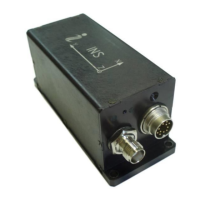INS
GUI User’s Manual
Inertial Labs, Inc
TM
Address: 39959 Catoctin Ridge Street, Paeonian Springs, VA 20129 U.S.A.
Tel: +1 (703) 880-4222, Fax: +1 (703) 935-8377 Website: www.inertiallabs.com
162
13.2. Processing of mark input signal
Since the INS firmware version 2.2.0.3 the MARK IN pin can be used for
mark input signal to trigger specific GNSS raw receiver data. TTL mark
pulse configuration is the same as Fig. 13.1 shows. Adjustment of
processing of the mark input signal is provided by the Inertial Labs
TM
INS
GUI since version 2.0.22.84 from 04/22/2016.
To control the processing of the mark input please go to “Options” menu,
then to “Devices Options”, “Triggers” tab (see Fig.4.4). There is possible:
to enable or disable processing of the mark input signal using check
box. Default is disaled processing of mark input;
to specify mark polarity (negative or positive). Default is negative
polarity;
to set an offset, in nanoseconds, to be applied to the time the mark
input pulse occurs. Default value is zero offset;
to set a time period, in milliseconds, during which subsequent pulses
after an initial pulse are ignored. Default value is 4 milliseconds,
minimum value is 2 milliseconds.
When a pulse is detected at mark input then the GNSS receiver generates
asynchronous MARK2POS and MARK2TIME logs which are added to the
raw GNSS data listed in the Table 12.1 in section “12. INS and GNSS data
post-processing”.
13.3. INS operation with LiDAR
For integration of Inertial Labs INS data with LiDAR it is necessary to make
the next connections of INS to LiDAR system:
use INS COM1 port for output of the main INS data;
use INS COM2 port for output of GNSS raw data generated by INS
onboard GNSS receiver;
connect INS COM3 port for output of $GPRMC messages issued by
INS onboard GNSS receiver to LiDAR;
connect pulse-per-second (PPS) signal generated by INS onboard
GNSS receiver to LiDAR;

